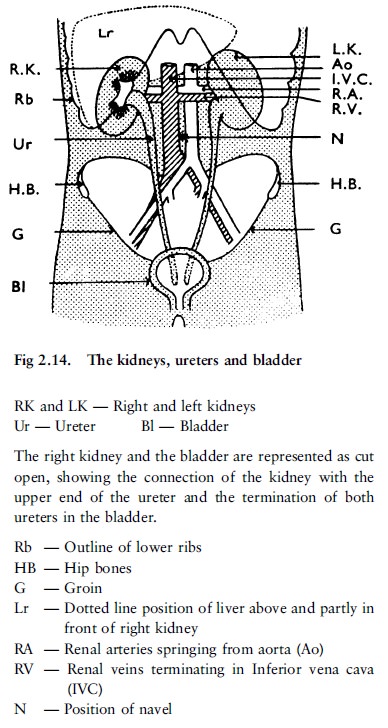Chapter: Forensic Medicine: Basic anatomy and physiology
Contents of the cavities of the chest and abdomen

Contents of the cavities of the chest and
abdomen
Contents of the cavities of the chest and
abdomen (fig 2.11)
The interior of the trunk houses the cavities of
the chest and abdomen, which are separated from each other at the level of the
lower ribs by a dome-shaped muscular partition called the diaphragm.

The chest cavity or thorax
The chest cavity is enclosed and protected by
the doralventebrae at the back and the ribs and breastbone at the sides and in
front.
It contains the following organs, most of which
are involved in the circulation of the blood or breathing:
·
On either side are the right and left lungs, which together fill the
greater part of the chest cavity.
·
The windpipe or trachea lies along the vertical middle of the neck and
divides into two smaller tubes, the right and left bronchus, each of which
enters the corresponding lung.
·
The central portion of the chest is occupied by the heart and the great
blood vessels which issue from it or enter it, namely the aorta and pulmonary
artery, and the corresponding great veins.
·
Behind the heart the gullet runs down from the neck where is lies behind
the windpipe, to the diaphragm through which it passes to enter the stomach.
The abdominal cavity or belly
The abdominal cavity contains a large number of
important organs most of which are involved in the digestion of food. It is
protected at the back by the backbone, above by the lower ribs, and at its
lowest portion by the pelvic bones. This portion lies wholly within the pelvis
and is called the pelvic cavity.
·
The stomach lies in the upper part of the abdomen immediately below the
diaphragm, and mainly to the left side of the middle line. It is continuous
with the gullet at the top and with the small intestine at its lower part.
·
The coils of the small intestine form a tube some six metres long, and
occupy the central portion of the abdomen.
·
In the right lower corner of the abdomen the small intestine joins the
large intestine, which passes up the right side of the abdomen, then across it
just below the stomach, and finally down the left side, and through the cavity
of the pelvis to end at the anus. The large intestine is about 1,5 m long.
·
A small worm-like blind tube about 10 cm long called the appendix is
affixed to the large intestine close to the point where the small intestine
enters it.
·
The mouth, throat, gullet, stomach, small intestine and large intestine
together form a continous tube, the digestive canal, through which the food
passes in digestion (fig 2.11, 2.12). Connected with the digestive canal in the
abdomen are two organs, the liver and the pancreas.

·
The liver occupies the right upper part of the abdomen, immediately
below the diaphragm, and extends across the middle line to the left. It lies
almost wholly under the lower ribs. This large organ produces the bile which,
after being stored in the gall bladder (a small sac at the lower end of the
liver) enters the small intestine not far from where the intestine begins by a
duct or tube (fig 2.12).
·
The pancreas lies in the angle between the stomach and the small
intestine. It produces an important digestive juice, and the duct which conveys
this juice to the small intestine enters the bowel at the same point as the
duct which carries the bile from the liver (fig 2.12).
·
To the left of the stomach, in the upper part of abdomen, covered by the
lower ribs, lies the spleen, an organ which inter alia helps with the formation
and break-down of blood.
·
The kidneys (fig 2.14) lie at the back of the abdominal cavity, one on
either side of the spine, with upper halves covered by the ribs. They are not
involved in digestion; their function is removal of waste matter from the body.
They withdraw water and other waste matter from the blood passing through them,
and this forms urine. The urine leaves each kidney through a tube (the ureter),
and both tubes enter the bladder, which lies in the pelvic cavity at front.
·
The abdomen also contains the lower part of the aorta and its branches,
the corresponding great veins, and many important nerves, especially sympathetic
nerves.


Related Topics